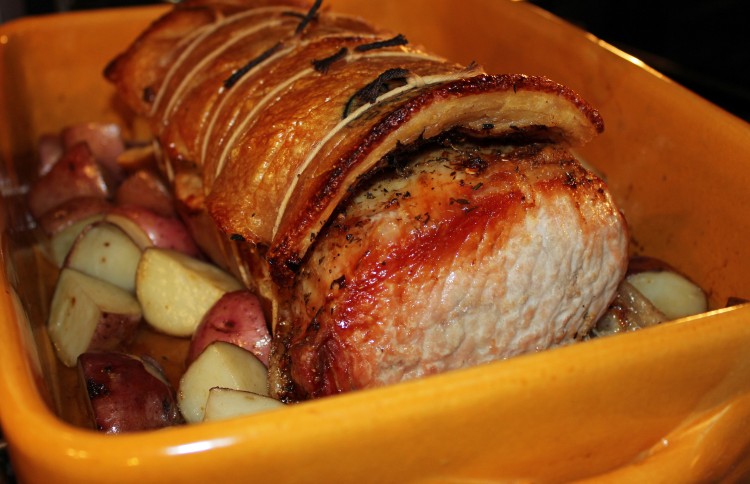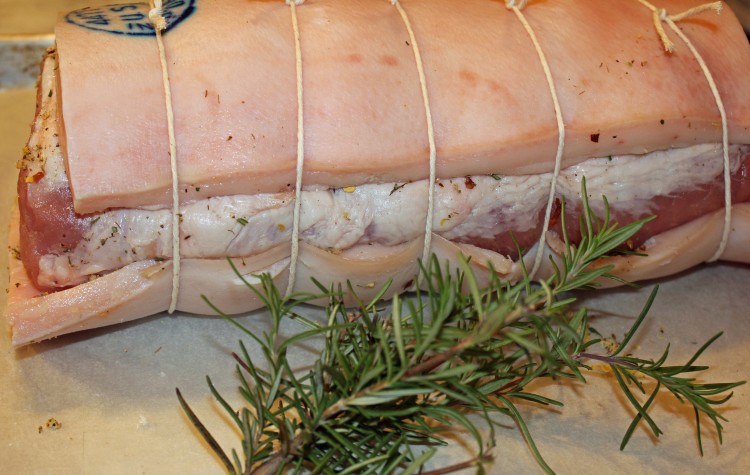“I’m doing that,” Suzen said. She pointed to the full page picture of this roast and went to get her car keys.
“You coming?” she asked at the door. “There’s a lot of stuff to carry.”
Well, not that much. Suzen had been scanning the pages of All About Roasting by Molly Stevens and stopped at this recipe. This is a dramatic roast, one that you’ll love showing off to family and friends. Best of all, it takes hours to cook. Your kitchen, your house, will be filled with aromatic treasures for the whole afternoon.
For this roast, Molly alerts you that you’ll need to shop at a specialty meat market, literally “one that goes beyond the standard supermarket fare.” This roast has three pieces: the boneless loin roast, the belly, and the skin. You’ll need a real butcher to help you here, but it is worth every bit of effort.
To make this, we added potatoes to cook for the last hour. It’s a one meal wonder.
Oven Roasted Porchetta
Yield: serves 8
Ingredients:
- 1 center-cut pork loin with the belly flap attached, preferably with skin on (8 to 9pounds), or 1 boneless center-cut pork loin (about 5 pounds) plus 1 pork belly (4 to 5 pounds)
- 4 to 6 garlic cloves, minced
- Kosher salt
- Coarsely ground black pepper
- 1 ½ tablespoons chopped fresh rosemary
- 1 tablespoon chopped fresh sage
- 1 tablespoon chopped fresh thyme
- 1 tablespoon fennel seeds, toasted and ground to a coarse powder
- 1 tablespoon finely grated lemon zest
- ½ teaspoon crushed red pepper flakes
Preparation:
TRIM THE PORK AND SCORE THE RIND. If you purchased a pork loin with the belly attached, unroll the roast so the skin side is down. Examine the belly portion and determine whether you need to trim away any of the top layer of fat. If the roast came without skin, turn it over and also trim away some of the fat from the top side if need be. All pork bellies have prodigious amounts of fat; how much you leave in place is a matter of personal preference. Ideally you want a layer just under ½ inch thick, so if the butcher has left more than this, use a large chefs knife to pare it down. (The fat can be saved for rendering or other use.)
If you’ve got a separate pork loin and pork belly, check that the outermost fat layer of the pork belly is less than ½inch thick. If needed, trim it down. Next, drape the belly (skin side up) around the pork loin (without tying it), just to get a sense of how it will fit. It doesn’t have to be perfect, but if it extends more than 1 inch over the ends of the loin, trim it down and save the trimmings for another use. If there’s a gap on the underside because the belly doesn’t reach all the way around, that’s fine. Also, if you’ve got a separate piece of pork skin, drape this over the roast and trim it to fit (poultry shears or utility scissors are useful here).
Now arrange the belly, whether separate or attached to the loin, so it is skin side up on a stable surface and, using a box cutter, utility knife, or other razor-sharp knife, carefully (but firmly) score the rind in parallel lines about ½-inch apart, cutting through the rind and just into the fat (about ½-inch deep) without cutting through to the meat. The lines can go in any direction that appeals to you.
SEASON AND TIE THE ROAST. In a small bowl, combine the garlic, 1 ½ tablespoons salt, 2 teaspoons black pepper, the rosemary, sage, thyme, fennel, zest, and red pepper flakes. For the single-piece roast, unroll the belly flap and sprinkle the seasonings evenly over the belly and the roast, rubbing lightly so the seasonings adhere. Roll the flap around the loin; if the skin is a separate piece, drape it over, and secure the whole porchetta at 1- to 2-inch intervals with kitchen string.
For the 2- or 3-piece roast, sprinkle half the seasonings all over the loin and the other half on the meat side of the belly, rubbing lightly so they stick, and then wrap the belly (skin side out) over the loin, so the belly covers the top side (fat side) of the roast thoroughly and any gap is on the bottom (or rib side). If the skin is a separate piece, drape it over the top. Secure the entire ensemble with kitchen string, tying loops at 1-to 2-inch intervals.
Season the surface of the roast lightly but evenly with salt and pepper (about ⅜ teaspoon each), getting some into the score marks as well. Set the roast on a tray or in a baking dish and refrigerate, uncovered or loosely covered, for 24 to 48 hours. Let the pork sit at room temperature for 1 to 2 hours before roasting.
HEAT THE OVEN. Position a rack in the lower third of the oven and heat to 500°F (475°F convection).
ROAST. Place the pork seam side down on a roasting rack in a sturdy roasting pan just large enough to accommodate it. Roast for 25 minutes and then reduce the oven temperature to 325°F degrees (300°F convection). Continue to roast until an instant-read thermometer inserted into the center of the roast registers 140 to 145°, another 3 hours or so—but it’s a good idea to start checking the temperature after another 2 hours.
REST AND CARVE. Transfer the roast to a carving board, preferably one with a trough. Let rest for at least 25 minutes (the roast can easily sit at room temperature for an hour and not suffer). Carve into ¼- to ½-inch-thick slices, removing the strings as you go and doing your best to give each serving a bit of the crackling rind. If the rind is too tough to slice through easily (or if it was a separate piece to begin with), remove it in larger chunks and transfer it to a second cutting board, where you can chop it into pieces to serve alongside the sliced roast.
Set a rack in the middle level of the oven and preheat to 350 degrees.
Source: All About Roasting by Molly Stevens


